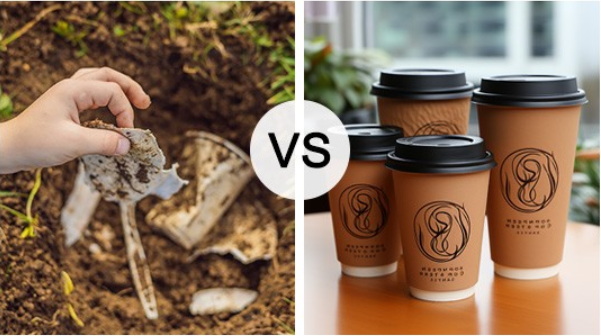
Content Menu
● Introduction to Compostable Coffee Cups
>> Benefits of Compostable Cups
>> Challenges with Compostable Cups
● Understanding Compostable Materials
>> Biodegradable vs. Compostable
● The Lifecycle of Compostable Cups
● Alternatives to Compostable Cups
● Case Studies: Implementing Sustainable Solutions
>> Starbucks' Compostable Coffee Cups
>> Cercle Melbourne's Reusable Cups
● Environmental Impact of Disposable Cups
>> Compostable Cups as a Solution
● Challenges in Implementing Compostable Cups
● Future Directions
● Conclusion
● FAQs
>> 1. What are compostable coffee cups made of?
>> 2. Do compostable cups really reduce waste?
>> 3. Can compostable cups be composted at home?
>> 4. Are recyclable coffee cups a better option than compostable ones?
>> 5. How can I ensure my disposable coffee cup is eco-friendly?
● Citations:
In recent years, the environmental impact of disposable coffee cups has become a significant concern. With billions of cups being used and discarded daily, the need for sustainable alternatives has never been more pressing. Compostable coffee cups have emerged as a promising solution, but are they truly eco-friendly? This article delves into the world of compostable coffee cups, exploring their benefits, challenges, and whether they live up to their eco-friendly promise.

Introduction to Compostable Coffee Cups
Compostable coffee cups are designed to break down naturally in the environment, reducing waste and supporting a healthier planet. Unlike traditional plastic cups, which can take hundreds of years to decompose, compostable cups are made from renewable resources such as plant-based fibers or cornstarch. These materials not only decrease the carbon footprint associated with production but also support the circular economy by continuously reusing, recycling, or composting materials.
Benefits of Compostable Cups
1. Reduced Waste: Compostable cups help reduce the amount of waste that ends up in landfills. By breaking down into nutrient-rich soil, they enrich the environment rather than polluting it.
2. No Microplastics: Unlike some biodegradable materials that can leave behind microplastics, compostable cups fully decompose without harmful residues.
3. Renewable Resources: Made from renewable materials, these cups reduce reliance on fossil fuels and support sustainable agriculture.
Challenges with Compostable Cups
Despite their benefits, compostable cups face several challenges:
1. Proper Disposal: Most compostable cups require industrial composting facilities to break down effectively. Without access to these facilities, they may end up in landfills, where they can release methane gases if they decompose anaerobically.
2. Consumer Awareness: There is often confusion about what "compostable" means. Many consumers assume that these cups can be composted at home, which is not always the case.
3. Infrastructure Limitations: The lack of commercial composting infrastructure in many areas means that even if cups are compostable, they may not be disposed of correctly.
Understanding Compostable Materials
Compostable coffee cups are typically made from materials like PLA (polylactic acid), which is derived from cornstarch or sugarcane. These materials are designed to break down in controlled environments, such as industrial composting facilities.
Biodegradable vs. Compostable
- Biodegradable: Materials that break down naturally over time but may leave behind residues or microplastics.
- Compostable: Materials that fully decompose into nutrient-rich soil under specific conditions, leaving no harmful residues behind.
The Lifecycle of Compostable Cups
The lifecycle of a compostable cup involves several stages:
1. Production: Made from renewable resources, reducing the carbon footprint compared to traditional plastic cups.
2. Use: Used once, then discarded.
3. Disposal: Ideally collected for industrial composting, where they break down into nutrient-rich soil.
4. Impact: If not composted correctly, they may end up in landfills, contributing to methane emissions.
Alternatives to Compostable Cups
While compostable cups offer a sustainable alternative to traditional disposable cups, there are other options worth considering:
1. Reusable Cups: Made from materials like stainless steel or bamboo, these cups can be used multiple times, significantly reducing waste.
2. Recyclable Cups: Though often challenging due to plastic linings, some recyclable cups can be processed into new products if disposed of correctly.

Case Studies: Implementing Sustainable Solutions
Starbucks' Compostable Coffee Cups
Starbucks has been at the forefront of testing compostable coffee cups, using a bio-based polybutylene succinate (bioPBS) lining that is both recyclable and home compostable. This pilot aims to reduce waste by ensuring that cups are collected and disposed of properly, either through recycling or composting. However, the success of this initiative depends on consumer behavior and the availability of appropriate waste management infrastructure[4].
Cercle Melbourne's Reusable Cups
In Melbourne, Cercle has introduced a reusable cup system to reduce disposable cup waste. By providing stainless steel cups that are durable and easy to clean, Cercle aims to divert thousands of single-use cups from landfills annually. This approach not only reduces waste but also encourages consumers to adopt more sustainable practices[6].
Environmental Impact of Disposable Cups
The environmental impact of disposable coffee cups is substantial. Traditional paper cups, for instance, have a significant carbon footprint, with each cup contributing up to 60.9 grams of CO2e. Moreover, the production process involves large amounts of water and energy, contributing to deforestation and habitat destruction[2].
Compostable Cups as a Solution
Compostable cups offer a promising solution by reducing the reliance on non-renewable resources and minimizing waste. Studies have shown that compostable takeaway coffee cups can decompose within six to twelve months under the right conditions, significantly reducing their environmental footprint compared to traditional plastic or paper cups[5].
Challenges in Implementing Compostable Cups
Despite their potential, compostable cups face several challenges:
1. Infrastructure: The lack of widespread industrial composting facilities means that many compostable cups end up in landfills or recycling streams, where they cannot decompose properly.
2. Consumer Education: There is a need for better consumer education on how to dispose of compostable cups correctly. Misconceptions about home composting can lead to improper disposal.
3. Standards and Regulations: The absence of clear standards for compostable materials can lead to confusion among consumers and manufacturers, affecting the overall effectiveness of these products[7].
Future Directions
To fully realize the potential of compostable coffee cups, several steps must be taken:
1. Investment in Infrastructure: Governments and businesses should invest in expanding industrial composting facilities to ensure that compostable materials are disposed of correctly.
2. Consumer Awareness Campaigns: Educational campaigns can help consumers understand the benefits and proper disposal methods for compostable cups.
3. Standardization: Establishing clear standards for compostable materials will help ensure consistency and effectiveness across different products.
Conclusion
Compostable coffee cups are a step towards reducing plastic waste and promoting sustainability, but their eco-friendliness depends heavily on proper disposal and infrastructure. While they offer many benefits, challenges such as consumer confusion and limited composting facilities hinder their full potential. As consumers, we must be aware of these challenges and advocate for better waste management systems.

FAQs
1. What are compostable coffee cups made of?
Compostable coffee cups are typically made from renewable resources such as plant-based fibers, cornstarch, or sugarcane. These materials are designed to break down naturally in the environment under specific conditions.
2. Do compostable cups really reduce waste?
Yes, compostable cups can significantly reduce waste by breaking down into nutrient-rich soil, but only if disposed of correctly in industrial composting facilities.
3. Can compostable cups be composted at home?
Most compostable cups, especially those made from PLA, require industrial composting facilities to break down effectively. However, some newer products are designed to be home compostable.
4. Are recyclable coffee cups a better option than compostable ones?
Recyclable cups can be a good option if they are disposed of correctly, but many recyclable cups have plastic linings that complicate recycling. Compostable cups are generally preferred for reducing plastic waste.
5. How can I ensure my disposable coffee cup is eco-friendly?
To ensure your disposable coffee cup is eco-friendly, choose cups that are either compostable or recyclable, and make sure they are disposed of in the appropriate facilities. Consider using reusable cups for the best environmental impact.
Citations:
[1] https://www.natureworksllc.com/about-natureworks/news/press-releases/2023/2023-11-15-wur-study-compostable-coffee-capsules-sustainability
[2] https://www.limepack.eu/blog/paper-cups-en/standard-vs-biodegradable-paper-cups-which-is-better-for-the-environment
[3] https://www.nature.com/articles/s41598-020-65058-1
[4] http://thecircularlaboratory.com/starbucks-compostable-coffee-cup-gamble
[5] https://mtpak.coffee/2024/06/environmental-impact-of-to-go-coffee-cups/
[6] https://www.sustainability.vic.gov.au/circular-economy-and-recycling/in-a-business-2/single-use-plastics-ban-centre/case-studies-reuse-pilot-projects/cercle-melbourne-case-study
[7] https://www.packagingforum.org.nz/compostable-coffee-cup-project/
[8] https://cupprint.com/composting-standards-why-certification-matters-in-2025/
[9] https://mtpak.coffee/2024/11/rise-of-recyclable-coffee-cups/
[10] https://www.compostablealternatives.com.au/coffee-cups-greenwashing/
[11] https://blogs.kent.ac.uk/kei-case-studies/2022/12/08/576/
[12] https://www.cbsnews.com/losangeles/news/starbucks-switches-to-compostable-cups-in-more-than-a-dozen-states/
[13] https://greenpaperproducts.com/blog/environmental-impact-of-coffee-cups
[14] https://www.plasticfreesa.org/post/cafe-ditches-disposable-coffee-cups
[15] https://mtpak.coffee/2024/11/compostable-paper-coffee-cups-made/
[16] https://cuploop.com/are-reusable-cups-greenwashing/
[17] https://www.researchgate.net/publication/342008722_Life_Cycle_Assessment_of_Compostable_Coffee_Pods_A_US_University_Based_Case_Study
[18] https://www.transparencymarketresearch.com/biodegradable-cups-market.html
[19] https://www.researchgate.net/publication/342746721_PEER-REVIEWED_REVIEW_ARTICLE_The_Future_of_Single-use_Paper_Coffee_Cups_Current_Progress_and_Outlook
[20] https://www.eng.mcmaster.ca/sites/default/files/uploads/disposable_coffe_cup_waste_reduction.pdf

















